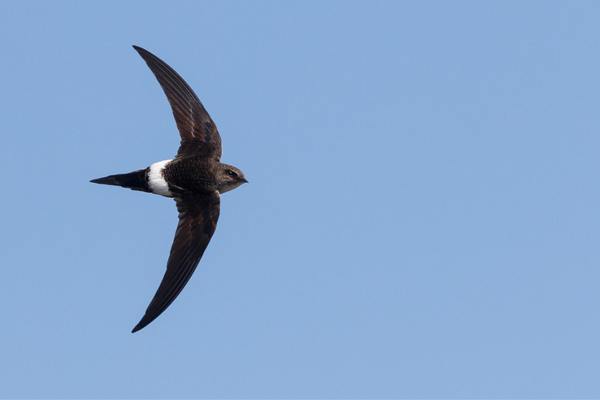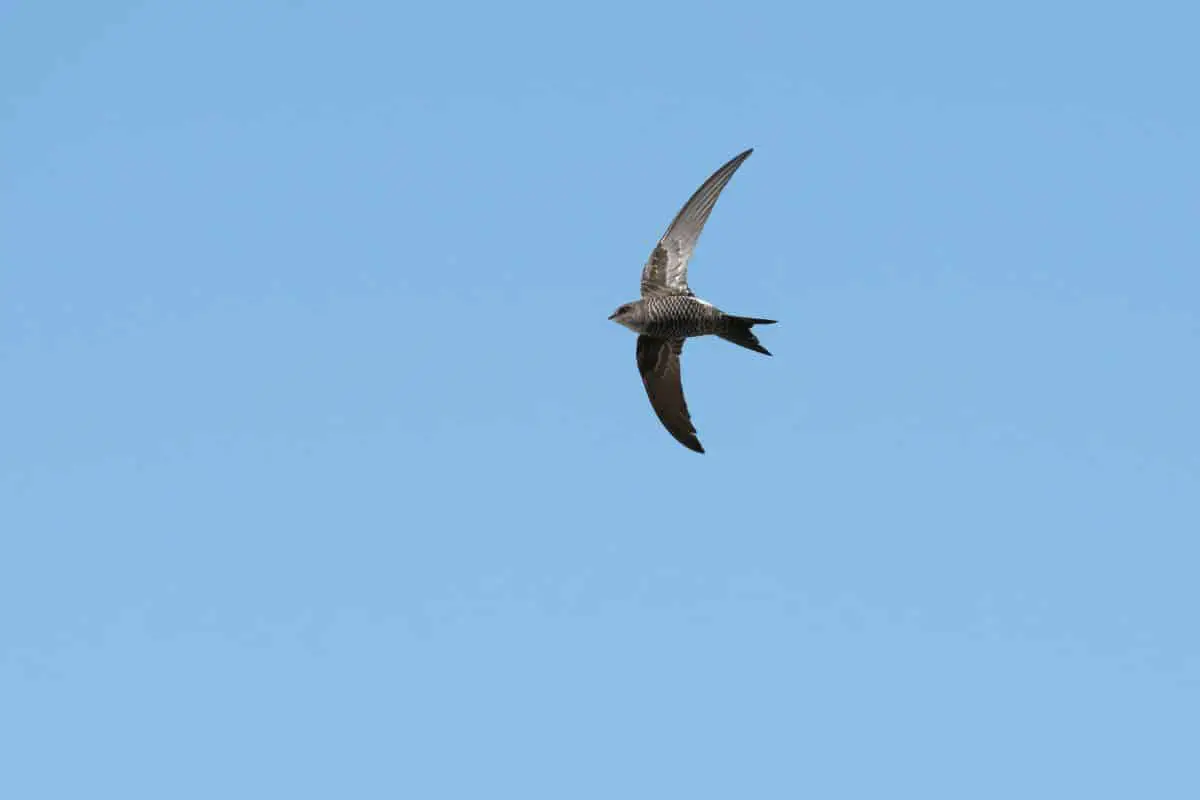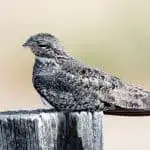Common Name: Fork-tailed Swift
Scientific Name: Apus pacificus| Size | Diet | Range in Hawaii | Status in Hawaii |
|---|---|---|---|
| 6.5 in. | Mosquitoes, flies, beetles, and other airborne invertebrates | Unknown | Least Concern |
The Fork-tailed Swift (Apus pacificus) is a fascinating bird species known for its distinctive forked tail and remarkable aerial acrobatics. These swifts are found across a vast range that spans from eastern Europe to eastern Asia, and they are known for their incredible endurance and speed in flight.
However, what many people may not know is that these swifts have also been spotted in Hawaii, a place where they are not native. In this article, we will explore the existence of Fork-tailed Swifts in Hawaii, and delve into what makes these birds so unique and captivating.
Fork-tailed swift
Appearance

The Fork-tailed Swift is a captivating aerial acrobat with a distinct appearance. It boasts a streamlined body measuring around 6.5 inches in length, making it a compact and agile flyer. The most remarkable feature of this species is its deeply forked tail, which splits into two long, slender extensions, earning it its name.
With its sleek black plumage, slender wings, and a silhouette that seems to slice through the air effortlessly, the Fork-tailed Swift is a visually striking bird that leaves an indelible impression as it zips through the skies with precision and grace.
Diet
As a highly skilled flyer, this species relies on its speed and agility to catch its preferred meal: flying insects. Mosquitoes, flies, beetles, and other airborne invertebrates make up the primary diet of the Fork-tailed Swift.
Nesting
These swifts are known for their choice of nesting sites, which are often found in the crevices of cliffs, rock faces, or the eaves of buildings. Using their specialized feet designed for clinging, they construct their nests using a combination of saliva, feathers, and plant materials.
What sets the Fork-tailed Swift apart is its propensity for communal nesting. Large colonies consisting of hundreds or even thousands of individuals gather together to build their nests in close proximity. This social nesting behavior not only provides protection against predators but also fosters a sense of cooperation among the birds.
During the breeding season, these colonies become a flurry of activity as individuals engage in courtship displays, aerial acrobatics, and vocalizations. The nests are strategically positioned to allow for easy take-off and landing, as these swifts spend most of their lives in the air.
Within the colonies, each pair of Fork-tailed Swifts constructs a small cup-shaped nest for their offspring. The eggs are incubated by both parents, and once hatched, the chicks grow rapidly due to the high-protein diet of their insectivorous parents. As the young swifts develop, they cling to the nest walls, gaining strength and coordination in preparation for their first flight.
Behavior

One of the most captivating behaviors of the Fork-tailed Swift is its synchronized group flying. In large flocks, these birds perform incredible aerial displays, soaring, gliding, and darting through the air in perfect harmony. Their coordinated movements create a mesmerizing spectacle as they twist and turn, creating intricate patterns across the sky.
Fork-tailed Swifts are diurnal birds, active during daylight hours, and are often seen foraging for insects high in the sky. They have a voracious appetite for flying insects and are known for their exceptional hunting skills. With their wide gape and agile flight, they effortlessly snatch prey mid-air, showcasing their precision and speed.
Interestingly, Fork-tailed Swifts have adapted to their aerial lifestyle in various ways. They have tiny legs and feet, making them ill-suited for walking or perching. Instead, they cling to vertical surfaces, such as cliffs or building walls, using their sharp claws. This behavior, combined with their specialized saliva, enables them to construct their nests in narrow crevices or under eaves.
These swifts are highly migratory, traveling vast distances between their breeding and wintering grounds. They undertake long and arduous journeys, sometimes covering thousands of miles, to take advantage of favorable seasonal conditions and abundant insect populations.
Habitat

In their breeding season, Fork-tailed Swifts are commonly seen in open habitats such as grasslands, savannahs, and meadows. They are particularly fond of areas near water bodies, including lakes, rivers, and marshes. During migration and winter, Fork-tailed Swifts venture to different regions, including coastal areas, forests, and even urban environments.
Range
The Fork-tailed Swift is not a native bird species to Hawaii, but it has been observed in the islands during its migration season. These swifts typically breed in eastern Asia and spend their winters in southeastern Asia and Australia.
During their migration, some individuals have been known to make their way to Hawaii, where they are considered rare visitors. While their sightings in Hawaii are infrequent, they have been spotted in various parts of the islands, including the Northwestern Hawaiian Islands.
Conservation Status
According to the International Union for Conservation of Nature (IUCN), the Fork-tailed Swift (Apus pacificus) is currently assessed as a species of “Least Concern.” This classification indicates that, while the species may face certain localized threats and habitat loss, its population is still relatively stable and widespread.
Interesting Facts
1. Fastest bird in level flight
Fork-tailed Swifts are known to be one of the fastest birds in level flight. They can reach impressive speeds of up to 170 kilometers per hour (105 miles per hour). This remarkable speed allows them to efficiently cover large distances during their migrations.
2. No time on the ground
Fork-tailed Swifts are highly adapted for life in the air and spend almost their entire lives flying. They are known to eat, drink, and even sleep while in flight. They have specialized adaptations, such as reduced leg muscles and tiny feet, which make them ill-suited for walking or perching on the ground.
3. Non-stop flight
These swifts are capable of sustained flight for extended periods without landing. During their long-distance migrations, they can fly continuously for several days or even weeks, taking short breaks only for feeding and drinking in mid-air.
4. Group huddling
During cold weather or at night, Fork-tailed Swifts engage in a behavior known as “huddling.” They gather closely together in large numbers, often touching each other, to conserve body heat. This behavior helps them maintain a stable body temperature in colder conditions.
5. Longevity
Although precise data on their lifespan is limited, it is estimated that Fork-tailed Swifts can live for up to 10 years or more. Their ability to navigate and endure long and arduous migrations suggests they have evolved to be long-lived birds.
Frequently Asked Questions
1. How fast can Fork-tailed Swifts fly?
Fork-tailed Swifts are known to be one of the fastest birds in level flight. They can reach speeds of up to 170 kilometers per hour (105 miles per hour) during their swift and agile flights.
2. Can Fork-tailed Swifts navigate in the dark?
Fork-tailed Swifts have excellent vision and are primarily diurnal (active during the day). However, in low-light conditions, they emit high-pitched clicks that help them navigate and detect obstacles in a manner similar to echolocation.
3. Are Fork-tailed Swifts culturally significant?
In some regions, Fork-tailed Swifts hold cultural significance. For example, in Japan, they are associated with the changing seasons and are considered a symbol of summer. They have been depicted in traditional art forms such as paintings and poetry.
4. How long do Fork-tailed Swifts live?
The exact lifespan of Fork-tailed Swifts is not well-documented. However, it is estimated that they can live up to 10 years or more in the wild.
5. How do Fork-tailed Swifts avoid collisions during their high-speed flights?
Fork-tailed Swifts have excellent maneuverability and visual acuity, which helps them avoid collisions during their rapid flights. They are skilled at detecting and avoiding obstacles in their flight path, utilizing their agility and quick reflexes.


